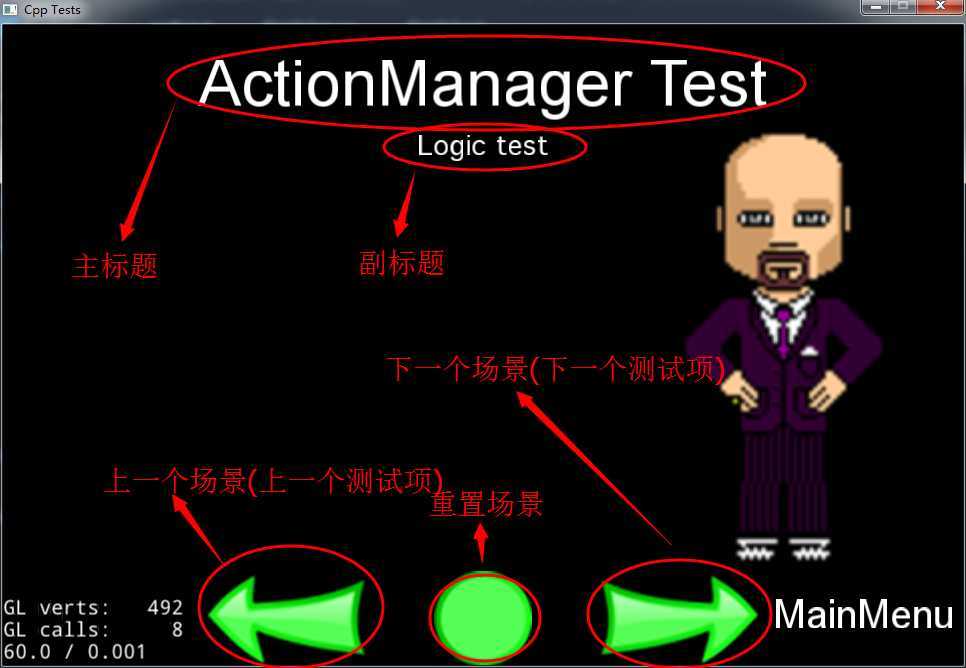标签:style blog http color io os ar 文件 2014
1 class BaseTest : public cocos2d::Layer 2 { 3 public: 4 virtual std::string title() const;// 主标题 5 virtual std::string subtitle() const;// 副标题 6 7 virtual void restartCallback(Ref* sender);// 重置场景回调 8 virtual void nextCallback(Ref* sender);// 下一个场景回调 9 virtual void backCallback(Ref* sender);// 上一个场景回调 10 11 virtual void onEnter() override;// 进入层时 12 virtual void onExit() override;// 退出层时 13 };
上面就是BaseTest类的头文件,里面只要提供了测试每个场景时用于场景的切换,其实就是测试项的切换,同时也是接口类,我们来看一下效果图:

接下我们来看一下实现BaseTest.cpp文件:
1 void BaseTest::onEnter() 2 { 3 Layer::onEnter(); 4 // ... 5 // 添加主标题 6 std::string str = title(); 7 const char * pTitle = str.c_str(); 8 9 TTFConfig ttfConfig("fonts/arial.ttf", /* 字号 */32); 10 auto label = Label::createWithTTF(ttfConfig,pTitle); 11 addChild(label, 9999); 12 label->setPosition( Vec2(VisibleRect::center().x, VisibleRect::top().y - 30) ); 13 // 添加副标题 14 std::string strSubtitle = subtitle(); 15 if( ! strSubtitle.empty() ) 16 { 17 ttfConfig.fontFilePath = "fonts/Thonburi.ttf";// 字体文件路径 18 ttfConfig.fontSize = 16;// 字体字号 19 auto l = Label::createWithTTF(ttfConfig,strSubtitle.c_str()); 20 addChild(l, 9999); 21 l->setPosition( Vec2(VisibleRect::center().x, VisibleRect::top().y - 60) ); 22 } 23 // 添加菜单图片项 24 auto item1 = MenuItemImage::create(s_pathB1, s_pathB2, CC_CALLBACK_1(BaseTest::backCallback, this) ); 25 auto item2 = MenuItemImage::create(s_pathR1, s_pathR2, CC_CALLBACK_1(BaseTest::restartCallback, this) ); 26 auto item3 = MenuItemImage::create(s_pathF1, s_pathF2, CC_CALLBACK_1(BaseTest::nextCallback, this) ); 27 28 auto menu = Menu::create(item1, item2, item3, nullptr); 29 // 设置位置 30 menu->setPosition(Vec2::ZERO); 31 item1->setPosition(Vec2(VisibleRect::center().x - item2->getContentSize().width*2, VisibleRect::bottom().y+item2->getContentSize().height/2)); 32 item2->setPosition(Vec2(VisibleRect::center().x, VisibleRect::bottom().y+item2->getContentSize().height/2)); 33 item3->setPosition(Vec2(VisibleRect::center().x + item2->getContentSize().width*2, VisibleRect::bottom().y+item2->getContentSize().height/2)); 34 35 addChild(menu, 9999); 36 }
上面的函数当进入层时调用可以重写,主要是显示主要标题,副标题,切换箭头图标,重置图标,至于其他嘛就没什么了。
1 /* 层退出时调用 */ 2 void BaseTest::onExit() 3 { 4 // ... 5 Layer::onExit(); 6 }
这个就不用说了,可以重写。
1 /* 这四个函数主要是继承时要进行重写 */ 2 std::string BaseTest::title() const 3 { 4 return ""; 5 } 6 7 std::string BaseTest::subtitle() const 8 { 9 return ""; 10 } 11 12 void BaseTest::restartCallback(Ref* sender) 13 { 14 log("override restart!"); 15 } 16 17 void BaseTest::nextCallback(Ref* sender) 18 { 19 log("override next!"); 20 } 21 22 void BaseTest::backCallback(Ref* sender) 23 { 24 log("override back!"); 25 }
这四个函数摆明就是要重写的,因为这个类是提供接口类,所以至于怎么切换还是要看后面怎么重写了。
这个总的来说,就是为其他类提供场景的切换功能。
Cocos2d-x_3.2 Demo ----------BaseTestt类
标签:style blog http color io os ar 文件 2014
原文地址:http://www.cnblogs.com/studweijun/p/3978249.html